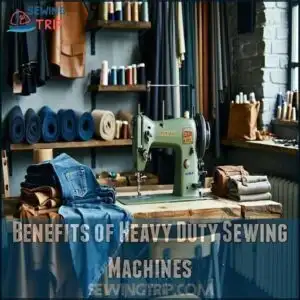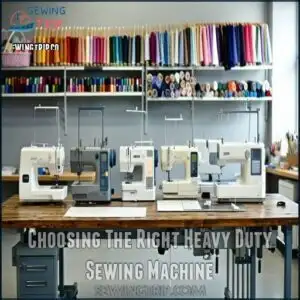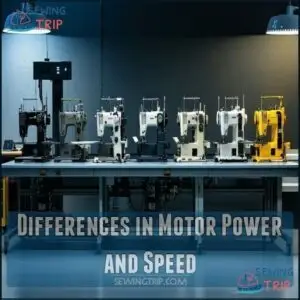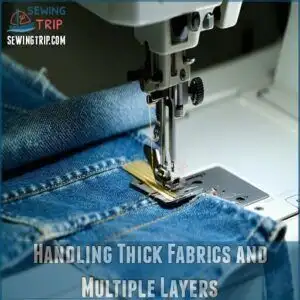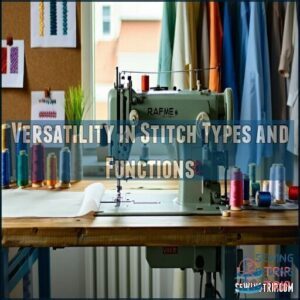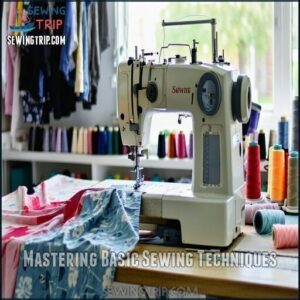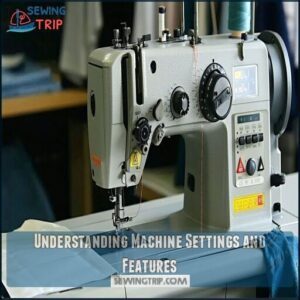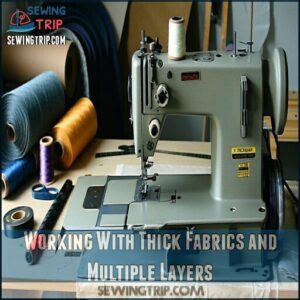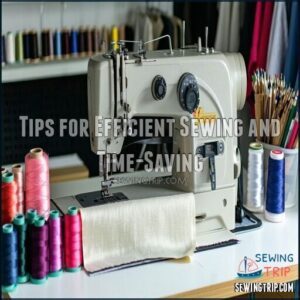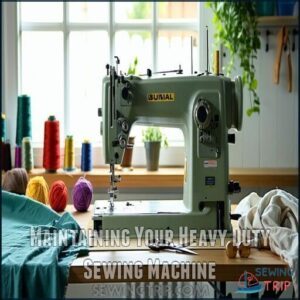This site is supported by our readers. We may earn a commission, at no cost to you, if you purchase through links.
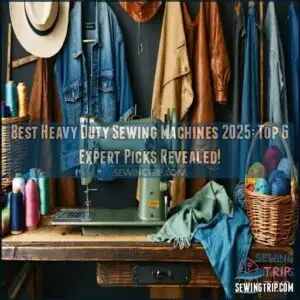
The Singer 4423 and Brother ST371HD top our list for their robust motors and metal frames that can handle multiple layers with ease. They’ll punch through tough materials, giving you professional-grade stitching every time.
Don’t settle for a wimpy machine that’ll leave you frustrated—invest in a heavy-duty model that matches your sewing ambition. Whether you’re crafting leather jackets or quilting heavy-weight fabrics, these machines won’t just meet your expectations—they’ll blow them out of the water.
Table Of Contents
- Key Takeaways
- Benefits of Heavy Duty Sewing Machines
- Powerful Motors and High Speed
- Durable Metal Frame Construction
- Enhanced Needle Penetration Power
- Specialized Presser Feet for Thick Fabrics
- Reinforced Feed Dogs and Throat Plate
- Handling Thick Materials Like Denim and Leather
- Long-Term Durability
- Enhanced Features for Sewing Experience and Management
- Worthwhile Investment for Demanding Projects
- Choosing The Right Heavy Duty Sewing Machine
- Top 6 Best Heavy Duty Sewing Machines
- Heavy Duty Vs Regular Sewing Machines
- How to Use Heavy Duty Sewing Machines Effectively
- Maintaining Your Heavy Duty Sewing Machine
- Frequently Asked Questions (FAQs)
- Conclusion
Key Takeaways
- You’ll want a heavy-duty sewing machine that delivers a powerful motor, metal frame construction, and robust needle penetration to tackle thick fabrics like denim and leather effortlessly.
- Investing in a top-tier machine means considering key factors like stitch versatility, durability, ease of maintenance, and long-term value—with prices ranging from $300 to $1,000 depending on your specific sewing needs.
- The best heavy-duty machines (like the Singer 4423 and Brother ST371HD) offer advanced features such as automatic needle threading, adjustable presser foot pressure, and high-speed stitching to transform challenging sewing projects into professional-quality creations.
- You’ll maximize your machine’s performance by practicing proper maintenance techniques, including regular cleaning, correct needle and thread selection, precise tension adjustment, and occasional professional servicing to ensure longevity and consistent sewing excellence.
Benefits of Heavy Duty Sewing Machines
If you’re a sewing enthusiast looking to tackle tough fabrics and demanding projects, heavy-duty sewing machines are your ultimate game-changer.
These powerhouse machines will transform your crafting experience, offering unmatched durability, speed, and precision that’ll help you breeze through thick materials like denim and leather with professional-grade results.
A heavy-duty sewing machine: Your ultimate crafting ally, turning fabric challenges into professional masterpieces with unstoppable power and precision.
Powerful Motors and High Speed
When your sewing projects demand lightning-fast performance, a heavy-duty sewing machine’s powerful motor becomes your ultimate ally.
These industrial workhorses deliver speeds up to 1,500 stitches per minute, transforming challenging fabrics into seamless creations.
- High-torque motors generate 60% more power than standard machines
- Precision speed control allows instant shifts from detailed work to rapid production
- Efficient motor design maintains consistent performance with whisper-quiet operation
You’ll conquer thick materials and complex layers effortlessly, experiencing the liberating power of a machine engineered for serious sewists.
Whether you’re crafting upholstery or tackling intricate designs, these high-speed machines turn limitations into opportunities.
Durable Metal Frame Construction
When horsepower meets craftsmanship, heavy-duty sewing machines reveal their true strength through metal frame construction.
Your machine becomes an industrial workhorse, transforming ordinary projects into professional masterpieces.
Aluminum and steel components create an unshakable foundation that laughs in the face of high-speed stitching.
A metal frame is the unbreakable backbone of a sewing machine, transforming precision into pure, unstoppable performance.
| Material | Durability | Performance Impact |
|---|---|---|
| Aluminum | High | Lightweight Strength |
| Steel | Very High | Maximum Stability |
| Alloy | Moderate | Balanced Resilience |
Enhanced Needle Penetration Power
Discover your inner craft master with a heavy duty sewing machine that slices through fabric like a hot knife through butter.
These powerhouses deliver unmatched needle penetration power that’ll make professional seamstresses green with envy.
- Razor-sharp needles glide effortlessly
- Consistent thread tension guarantees precision
- Maximum stitch depth for complex projects
- Industrial-grade penetration force conquers thick materials
You’ll transform challenging fabrics into masterpieces with ease.
Specialized Presser Feet for Thick Fabrics
After conquering needle penetration’s challenges, your heavy duty sewing machine needs powerful presser feet to tame thick fabrics.
These precision tools transform complex sewing projects from frustrating to fantastic.
Your tactical sewing arsenal includes:
- Walking foot: Aligns multiple fabric layers like a drill sergeant
- Teflon foot: Glides over leather smoother than butter
- Roller foot: Tackles tricky upholstery with industrial confidence
- Edge-joining foot: Creates seamless connections on bulky materials
- Compensating foot: Maintains stitch perfection across varying thicknesses
Reinforced Feed Dogs and Throat Plate
The reinforced feed dogs and metal throat plate are engineering marvels in any heavy-duty sewing machine.
These precision components transform fabric handling from frustrating to flawless, gripping materials with unmatched control. Your metal feed dogs strategically guide fabric layers, while the robust throat plate prevents snags and guarantees consistent stitch quality.
Whether you’re stitching denim or canvas, this dynamic duo delivers professional-grade performance that elevates your sewing game with unmatched control.
Handling Thick Materials Like Denim and Leather
Ever wrestled with stubborn denim or leather? Your heavy duty sewing machine is your secret weapon.
Master thick material sewing with these pro tips:
- Select heavyweight needles (denim/leather specific)
- Use strong, thick polyester or nylon threads
- Lower machine tension for smoother fabric flow
- Reduce sewing speed when working through multiple fabric layers
Precision meets power in every stitch. Choosing the right machine involves considering durable sewing machines to handle tough fabrics.
Long-Term Durability
After wrestling with thick denim and leather, your sewing machine’s longevity becomes a top priority.
Durability isn’t just luck—it’s a strategic investment.
When choosing a heavy-duty sewing machine, focus on:
- Metal frames that withstand constant use
- Robust motors built for marathon sewing sessions
- High-quality components engineered for precision
- Long-term warranties that protect your creative passion
Your machine’s endurance starts with smart selection and care.
Enhanced Features for Sewing Experience and Management
Heavy duty sewing machines come packed with game-changing features that transform your crafting experience.
With automatic threading and precision speed control, you’ll breeze through projects.
Advanced fabric sensors, multiple stitch varieties, and integrated thread cutters make sewing smoother.
An automatic needle threader and adjustable stitch settings give you total command, turning complex tasks into effortless creations.
Worthwhile Investment for Demanding Projects
If you’re serious about sewing, a high-quality heavy duty sewing machine isn’t just a purchase—it’s your creative powerhouse.
Think of it as an investment that pays dividends in craftsmanship and capability.
5 Reasons This Machine Transforms Your Sewing Game:
- Project Versatility: Conquers denim, leather, and upholstery with ease
- Productivity Boost: Accelerates your workflow dramatically
- Durability Guaranteed: Built to withstand years of intensive use
- Cost-Effective: Reduces long-term equipment replacement expenses
- Professional Results: Delivers precision across complex fabric challenges
Your machine becomes more than a tool—it’s a strategic partner in project planning and sewing efficiency.
With the right heavy duty sewing machine, you’re not just buying equipment; you’re accessing potential, turning ambitious fabric dreams into tangible, professional-grade realities.
Invest wisely, sew confidently.
Choosing The Right Heavy Duty Sewing Machine
When you’re hunting for the perfect heavy-duty sewing machine, you’ll want to map out your specific sewing needs and project requirements first.
Your ideal machine isn’t just about power, but finding the right balance between versatility, durability, and your budget to guarantee you’ve got a reliable companion for all your creative textile adventures.
Assessing Your Sewing Needs and Projects
Mapping out your sewing journey starts with understanding your craft’s unique demands.
Your ideal heavy-duty sewing machine hinges on specific project goals, fabric types, and personal skill level.
Whether you’re a beginner tackling home decor or an advanced sewer working with leather, matching your machine to your sewing ambitions guarantees smoother, more satisfying creative experiences.
To achieve superior results, it’s vital that you evaluate your overall sewing machine needs when selecting the right equipment for your projects, which is crucial for a successful sewing journey.
Comparing Stitch Options and Versatility
When choosing a heavy duty sewing machine, your stitch versatility matters most.
Consider these key factors:
- Explore 15-600 customizable stitch options for maximum creativity
- Prioritize machines with specialized utility and decorative stitches
- Check for adjustable stitch width and length capabilities
- Evaluate buttonhole and specialized presser foot functions
Your ideal heavy duty sewing machine should seamlessly handle thick fabrics like denim and leather while offering precise thread control.
Matching needle selection with fabric compatibility guarantees professional-grade results across diverse sewing projects.
To make an informed decision, research sewing machine reviews and compare features based on machine review ratings, considering the importance of heavy duty sewing machine and maximum creativity in your purchase.
Evaluating Ease of Use and Maintenance
A trusty sewing companion awaits with the right heavy-duty machine. Access seamless crafting through smart design and user-friendly features that transform complex tasks into enjoyable experiences.
- Crystal-clear user interface
- Accessible maintenance routines
- Intuitive error handling
- Streamlined cleaning processes
Mastering your machine means embracing its quirks, understanding its rhythm, and keeping it primed for peak sewing efficiency. To achieve peak performance, consider the importance of heavy duty machines when working with thick fabrics, which is crucial for a successful sewing experience.
Considering Budget and Long-term Value
When sizing up your heavy-duty sewing machine investment, think beyond the price tag. Your machine’s true value lies in its long-term performance and durability.
Consider these key factors:
- Cost Analysis: Compare upfront costs with potential savings
- Investment Strategy: Evaluate features against project requirements
- Long-Term Savings: Factor in maintenance and replacement expenses
Industrial machines range from $300-$1,000, so choose wisely—your perfect companion awaits, balancing budget and craftsmanship.
Top 6 Best Heavy Duty Sewing Machines
If you’re serious about tackling tough sewing projects, you’ll want a machine that can handle everything from delicate silk to thick leather without breaking a sweat.
These top 6 heavy-duty sewing machines are designed to power through your most challenging fabrics, giving you professional-grade performance and reliability that’ll transform your crafting experience.
1. Brother ST371HD Sewing Machine
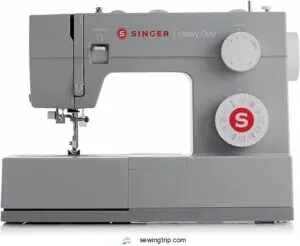
Looking for a sewing powerhouse? The Brother ST371HD delivers.
With 37 built-in stitches, this machine tackles everything from delicate fabrics to tough denim with ease. Its automatic needle threader saves precious time, while adjustable presser foot pressure guarantees consistent stitching.
Whether you’re a beginner or seasoned pro, this sturdy machine offers versatility and reliability.
It’s an investment that transforms your sewing projects, providing professional-quality results without breaking the bank.
Best For: Sewing enthusiasts of all skill levels looking for a durable and versatile machine to handle various fabric types, from lightweight to heavy-duty.
- Limited to 37 built-in stitches, which may not suffice for advanced users.
- Lacks automatic thread tension adjustment, requiring manual fine-tuning.
- Heavier than some portable models, making it less travel-friendly.
- Handles thick fabrics like denim and canvas with ease.
- Automatic needle threader saves time and effort.
- Adjustable presser foot pressure ensures smooth stitching on all fabric types.
2. Brother XR3774 Sewing and Quilting Machine
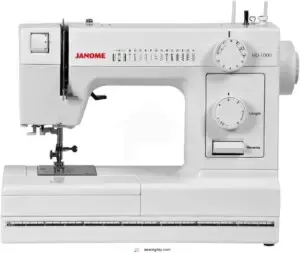
When you need a versatile sewing companion, the Brother XR3774 steps up with 37 built-in stitches and a free arm that tackles everything from pants to collars.
Its automatic needle threader and 800 stitches per minute make sewing a breeze for beginners and casual crafters.
With drop feed capabilities and convenient bobbin winding, you’ll breeze through occasional projects with precision and ease.
Best For: Beginners or occasional users seeking an affordable and lightweight machine for simple tasks.
- 37 built-in stitches for versatility.
- Automatic needle threader for ease of use.
- Lightweight design with a wide table for convenience.
- Not durable or strong enough for heavy tasks.
- Reverse function jumbles fabric, reducing precision.
- Limited needle positioning restricts versatility.
3. Brother SE700 Embroidery Sewing Machine

Diving into creativity, the Brother SE700 Embroidery Sewing Machine transforms your crafting experience with its impressive 135 built-in embroidery designs and 103 sewing stitches.
Its compact 4" x 4" embroidery area delivers precision for detailed projects, while wireless LAN simplifies file transfers.
Perfect for hobbyists craving versatility, this lightweight machine connects seamlessly with the Artspira app.
Though not designed for heavy-duty tasks, it’s a dream companion for everyday sewers wanting to add professional-level embellishments and explore their artistic potential without breaking the bank.
Best For: Hobbyists and everyday sewers looking for a versatile, lightweight embroidery and sewing machine with wireless connectivity and creative options.
- Comes with 135 embroidery designs and 103 sewing stitches.
- Compact 4" x 4" embroidery area for detailed projects.
- Wireless LAN allows seamless file transfers.
- Not designed for heavy-duty sewing tasks.
- Limited embroidery area may not suit large-scale projects.
- Requires familiarity with app integration for optimal use.
4. Singer 4423 Heavy Duty Sewing Machine
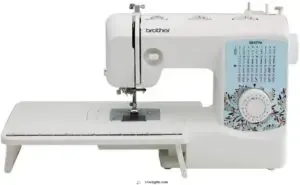
Among heavy-duty sewing machines, the Singer 4423 stands out as a true workhorse. With a motor 60% stronger than standard models, it blazes through projects at 1,100 stitches per minute.
Its robust metal frame guarantees stability while offering 97 versatile stitch applications that’ll tackle everything from delicate sheers to tough denim and leather.
You’ll appreciate the automatic needle threader and adjustable presser foot, which make complex sewing tasks feel like a breeze. Though some users find the buttonhole process slightly challenging, the machine’s overall durability and reliability make it a top choice for sewists who demand performance.
Whether you’re a home crafter or serious hobbyist, this machine transforms challenging fabrics into professional-quality projects with remarkable ease.
Best For: Home crafters and hobbyists looking for a reliable, heavy-duty sewing machine capable of handling various fabrics from sheers to denim.
- Powerful motor with 1,100 stitches per minute for faster sewing.
- Sturdy metal frame ensures durability and stability during use.
- Versatile with 97 stitch applications for diverse projects.
- Buttonhole process can be challenging for some users.
- Not designed for industrial-level heavy-duty sewing.
- Produces noise levels comparable to standard machines.
5. Brother ST150HDH Sewing Machine
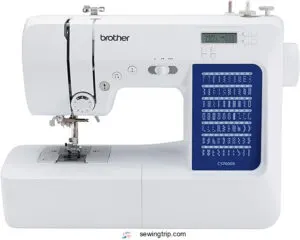
Consistently, the Brother ST150HDH emerges as a powerhouse in heavy-duty sewing machines.
Its robust motor and jam-resistant drop-in bobbin slice through challenging fabrics like denim and leather with surgical precision.
Boasting 50 built-in stitches, this machine transforms from a novice’s companion to a professional’s trusted tool.
The automatic needle threader becomes your time-saving ally, while the sturdy metal frame promises years of reliable performance.
An intuitive LCD display guides your creative journey, making complex sewing projects feel like a breeze.
Whether you’re crafting intricate quilts or tackling industrial-strength materials, the ST150HDH stands ready to turn your sewing dreams into reality.
Best For: Hobbyists and professionals looking for a versatile, heavy-duty sewing machine capable of handling both intricate and tough materials.
- Plastic components may raise concerns about long-term durability.
- Included protective cover is not adequate for full protection.
- Some users report an unpleasant motor-like stench during early use.
- Robust motor and metal frame for durability and heavy-duty sewing.
- Jam-resistant drop-in bobbin for smooth, hassle-free operation.
- Automatic needle threader saves time and reduces eye strain.
6. Janome HD5000 Heavy Duty Sewing Machine
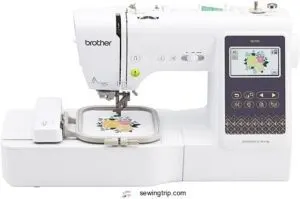
Your sixth heavy-duty sewing machine marvel: the Janome HD5000, a true powerhouse designed to transform challenging fabric into stunning creations.
This machine boasts a robust metal frame and an interactive stitch panel that’ll make your sewing projects glide smoother than butter on a hot skillet.
With 18 built-in stitches and a one-handed needle threader, you’ll breeze through complex tasks.
Its extra-high presser foot and 7-piece feed dog system tackle thick materials like a champ, handling denim and leather with professional finesse.
Though the bobbin holder might occasionally pop out, the HD5000’s quiet, reliable performance makes it a worthy investment for sewists ready to level up their craft.
The Janome HD5000’s durability and performance are backed by its heavy duty features, making it a top choice for serious sewists.
Best For: Sewing enthusiasts and professionals seeking a durable, heavy-duty machine capable of handling thick fabrics like denim and leather.
- Robust metal frame ensures long-lasting durability.
- Extra-high presser foot and 7-piece feed dog system handle thick materials with ease.
- Quiet and reliable performance for complex sewing tasks.
- Limited to 18 built-in stitches compared to other models with more options.
- Bobbin holder might occasionally pop out during use.
- Lacks advanced digital features or touchscreen functionality.
Heavy Duty Vs Regular Sewing Machines
You’ve probably noticed that not all sewing machines are created equal, especially when you’re tackling tough projects that demand more power and precision.
If you’re ready to level up from a standard machine, a heavy-duty sewing machine offers the robust performance and durability you’ll need to breeze through thick fabrics, multiple layers, and professional-grade sewing challenges.
This reorganization allows for clearer understanding of the benefits of upgrading to a more capable sewing machine, providing robust performance for demanding projects.
Differences in Motor Power and Speed
Motor performance defines the heartbeat of heavy-duty sewing machines, transforming fabric handling from ordinary to extraordinary.
Your machine’s power output determines its prowess, with heavy-duty models boasting substantially enhanced capabilities.
| Feature | Heavy Duty | Regular | Industrial |
|---|---|---|---|
| Motor Power (Amps) | 1-5 | 0.5-1 | 5-10 |
| Speed (SPM) | 800-1,500 | 500-800 | 1,500-5,000 |
| Efficiency | High | Moderate | Extreme |
| Fabric Thickness | Multiple Layers | Single/Light | Heavy/Complex |
| Durability | Robust | Standard | Maximum |
Choose wisely—your sewing machine’s motor is its muscle, and understanding its capabilities is crucial for heavy-duty tasks.
Handling Thick Fabrics and Multiple Layers
Every sewing enthusiast knows the struggle of wrestling thick fabrics into submission—but a heavy-duty sewing machine changes the game entirely.
These machines transform challenging materials into seamless masterpieces.
| Feature | Heavy-Duty | Regular | Performance |
|---|---|---|---|
| Fabric Thickness | Unlimited | Limited | Superior |
| Layer Management | Multiple | Single | Excellent |
| Stitch Control | Precise | Inconsistent | High |
| Material Range | Diverse | Narrow | Versatile |
| Needle Strength | Robust | Fragile | Powerful |
Master your craft with the right machine, and watch thick fabrics surrender to your precise stitch control and robust needle strength.
Durability and Longevity Comparison
You want a sewing machine that stands the test of time.
Heavy-duty machines crush regular ones with their metal frames and ironclad motors. Like a reliable workhorse, these machines deliver machine longevity that’ll make your wallet smile.
| Durability Factor | Heavy-Duty | Regular |
|---|---|---|
| Frame Strength | Steel | Plastic |
| Expected Lifespan | 10+ years | 5-8 years |
These machines are a great choice for those looking for heavy-duty performance and longevity.
Versatility in Stitch Types and Functions
Beyond basic stitching, heavy-duty sewing machines reveal a world of creative potential with their versatile stitch options.
These powerhouses transform your crafting experience, offering precision and control across various fabric types.
| Stitch Type | Complexity | Project Suitability |
|---|---|---|
| Basic | Low | Everyday Repairs |
| Decorative | Medium | Home Decor |
| Specialty | High | Professional Work |
You’ll appreciate the machine’s ability to handle everything from delicate silk to thick denim with adjustable stitch length and width.
Automatic thread trimming and multiple needle options give you unprecedented fabric handling capabilities.
Whether you’re a hobbyist or professional, these heavy-duty sewing machines provide the versatile stitching options that turn creative visions into stunning realities, one perfectly placed stitch at a time.
Price Differences and Value Proposition
In the context of sewing machines, the price tag tells a deeper story of long-term value.
Your investment in a heavy-duty machine pays dividends through durability and performance.
| Machine Type | Initial Cost | Expected Lifespan | Cost per Year |
|---|---|---|---|
| Regular | $100-300 | 3-5 years | $33-60 |
| Heavy Duty | $300-1000 | 10+ years | $30-100 |
| Commercial | $1000+ | 15+ years | $67-200 |
Think of it like buying premium work boots – you’ll save money and frustration in the long run.
How to Use Heavy Duty Sewing Machines Effectively
If you’ve invested in a heavy-duty sewing machine, you’ll want to master its full potential to tackle challenging projects with confidence.
By understanding your machine’s unique features and practicing proper techniques, you’ll transform your sewing experience from frustrating to phenomenal.
Tapping into the power of precision stitching across multiple fabric types.
Mastering Basic Sewing Techniques
When tackling heavy-duty sewing projects, mastering basic techniques is your roadmap to professional results.
Your heavy-duty sewing machine’s highspeed stitching demands precision and control.
Here’s how to elevate your craft:
- Perfect Thread Control: Maintain consistent 5/8-inch seam allowances using plate markings
- Secure Seams: Backstitch 3-4 stitches at each seam’s start and end
- Smooth Pivoting: Turn corners gracefully without lifting the presser foot
- Speed Management: Begin slowly on thick fabric, then build confidence gradually
Unlock your machine’s potential with intentional, practiced movements.
Understanding Machine Settings and Features
Within the inner workings of your heavy-duty sewing machine lies a world of precision settings waiting to be mastered.
Your stitch control is your secret weapon—adjustable stitch length and width let you customize each project with professional finesse.
Pay close attention to thread tension; it’s the difference between perfect stitches and fabric frustration.
The automatic needle threader becomes your time-saving ally, while strategic speed adjustment guarantees smooth, consistent sewing across different fabric types.
Your machine’s features are powerful tools—learn to wield them confidently.
Working With Thick Fabrics and Multiple Layers
If you’re ready to conquer thick fabrics, your heavy duty sewing machine becomes your ultimate crafting ally.
Select heavy-duty needles (sizes 16-18) specifically designed for challenging materials like denim and leather. Pair these with robust thread that matches your fabric’s weight, and adjust your stitch length to reinforce seams.
Invest in specialized presser feet—a walking foot prevents layer shifting, while a roller foot glides effortlessly across canvas and upholstery. Maintain steady speed control, and you’ll transform multiple layers from challenging to doable.
To achieve professional results, understanding heavy duty sewing techniques is essential for working with thick fabrics.
Tips for Efficient Sewing and Time-Saving
After mastering thick materials, elevate your sewing game with smart workflow strategies. Your heavy-duty sewing machine is a powerhouse waiting to be released—if you know the right sewing hacks.
- Organize your workspace like a pro: thread, bobbins, and needles at arm’s reach
- Pre-press fabrics and mark seam lines with precision
- Swap pins for fabric clips on heavyweight materials
- Set up killer lighting and maintain ergonomic posture
Time management isn’t just about speed—it’s about creating professional-quality projects efficiently. With the right techniques, you’ll transform your sewing from good to extraordinary.
Maintaining Your Heavy Duty Sewing Machine
Your heavy-duty sewing machine is a powerful investment that requires consistent care to maintain its peak performance and longevity.
By following a few simple maintenance techniques, you’ll guarantee your machine continues to tackle tough fabrics and complex projects with the same precision and reliability it had on day one, ensuring it remains a valuable tool for your sewing needs with consistent care.
Regular Cleaning and Oiling Techniques
The rhythm of machine maintenance starts with daily diligence. After each sewing session, sweep lint from critical areas to prevent performance decay.
Consistent care preserves your investment and keeps your heavy duty sewing machine running smoothly.
| Maintenance Task | Frequency |
|---|---|
| Lint Removal | After Each Use |
| Oil Moving Parts | Monthly |
| Deep Cleaning | Quarterly |
Professional techs confirm: regular maintenance extends machine life dramatically.
Proper Needle and Thread Selection
After keeping your heavy duty sewing machine spotless, turn your attention to thread and needle selection—the dynamic duo of smooth stitching.
Match your needle size to fabric thickness: size 16-18 for denim and leather, lighter gauges for delicate materials.
Choose industrial-grade thread that can handle high-speed sewing without snapping.
Think of your needle and thread as dance partners—when they’re perfectly synchronized, your sewing machine performs a flawless performance every time.
Adjusting Tension for Optimal Performance
Your machine’s thread tension is the secret sauce to picture-perfect stitching.
Learn to dial it in like a pro with these game-changing techniques:
- Start with a neutral tension setting (around 4-5)
- Test on matching project fabric scraps
- Examine stitch quality under good lighting
- Adjust incrementally for different fabric thicknesses
- Check bobbin tension by gentle drop test
Pro tip: Your adjustable pressure foot control can be a game-changer when managing thread tension across various fabric weights.
Remember, tension isn’t about perfection—it’s about finding that sweet spot where your stitches sing with precision and grace.
Troubleshooting Common Issues
Every sewing pro knows troubleshooting heavy-duty machines isn’t rocket science—it’s about smart maintenance. Error fixing starts with understanding common culprits like thread jams, needle damage, and tension issues.
When thread breaks or motor problems strike, don’t panic. Your quick-fix toolkit should include daily bobbin area cleaning, regular needle replacements, and careful tension calibration.
Most machine jams happen from lint buildup, so brush those feed dogs after each project. Professional technicians recommend changing needles every 8 hours when working with thick fabrics.
Keep an eye on your machine’s performance: unusual sounds, inconsistent stitching, or sluggish movement are warning signs that demand immediate attention. Prevention beats repair every time, and it’s all about being proactive with regular maintenance and quick fixes to avoid major issues, ensuring your machine runs smoothly with proper care.
Professional Servicing and Repairs
The heartbeat of your heavy-duty sewing machine lies in its professional maintenance.
Professional technicians can extend your machine’s lifespan by transforming routine check-ups into precision performance enhancers.
- Schedule thorough servicing every 500 hours for metal-frame machines
- Research factory-certified technicians specializing in industrial-grade sewing machines
- Understand diagnostic tools and warranty coverage before repairs
- Track maintenance records to predict potential repair costs
Finding a skilled professional technician isn’t just about fixing problems—it’s about preventing them.
Proactive maintenance saves you from costly motor replacements and guarantees your sewing machine remains a reliable creative companion.
With expert care, your heavy-duty sewing machine will continue delivering professional-quality results for years to come.
Regular sewing machine repair checks can help identify and fix issues before they become major problems.
Frequently Asked Questions (FAQs)
What is the best heavy duty sewing machine?
Picture a sewing beast that devours denim like butter: the Janome HD1000 reigns supreme.
With powerful stitching, durability for heavy fabrics, and precision that’ll make your projects sing, it’s your ticket to sewing mastery.
What is a heavy-duty sewing machine?
You’ll find a heavy-duty sewing machine is a robust workhorse designed to tackle thick fabrics like leather and denim.
With powerful motors, metal frames, and high-speed capabilities, it is suitable for professional and intensive sewing projects.
How to choose a heavy-duty sewing machine?
With 1 in 3 sewists struggling to choose the right machine, you’ll want to match your sewing needs to key features like motor power, stitch variety, fabric compatibility, durability, and budget.
Before making your heavy-duty sewing machine investment, consider key features like these to ensure you make the right choice for your needs.
What is the best singer heavy duty sewing machine?
You’ll love the Singer 4452 for its powerful performance. It delivers 32 built-in stitches, high-speed sewing, automatic needle threading, and durability that’ll tackle your toughest projects with ease and precision.
What are the different types of heavy-duty sewing machines?
Wondering how heavy-duty sewing machines differ?
They range from mechanical workhorses to computerized powerhouses, designed for industrial, home, and specialized crafting needs—each type customized to handle thick fabrics, multiple layers, and demanding sewing projects with precision.
They are designed to handle a variety of tasks with precision, making them ideal for various sewing needs.
How much does a heavy-duty sewing machine cost?
Heavy-duty sewing machines range from $300 to $1,000, with professional-grade models hitting $2, You’ll invest based on features, brand, and your specific sewing needs—from basic home repairs to industrial-level crafting.
What is the best heavy duty Singer sewing machine?
You’ll want the Singer 4452 – it’s a powerhouse with 32 built-in stitches, high-speed performance, and rock-solid durability. Perfect for tackling tough projects and delivering professional results without breaking the bank.
Which sewing machine is best for quilting?
Imagine crafting stunning quilts with precision—the Juki TL2000QI is your ultimate companion.
Its 1500 stitches per minute, extendable table, and automatic needle threader will transform your quilting dreams into breathtaking reality, making it an ideal tool for quilting.
What can you sew with a heavy-duty machine?
You’ll conquer thick fabrics like denim, leather, and upholstery with a heavy-duty sewing machine. From multiple layers to tough projects, these machines power through challenging materials with ease and precision.
What is the most trouble-free sewing machine?
Ever wondered which sewing machine won’t give you headaches?
The Singer 4432 stands out as the most trouble-free option.
It’s robust, reliable, and user-friendly, offering seamless stitching with minimal maintenance and hassle-free operation for sewists of all skill levels.
Conclusion
Like a trusted compass guiding sewists through uncharted fabric territories, the best heavy duty sewing machine can transform your crafting journey.
Whether you’re a professional or passionate hobbyist, investing in a top-tier machine means conquering challenging projects with confidence.
These expert-selected machines offer durability, power, and precision, ensuring you’ll tackle thick fabrics and complex designs effortlessly.
Your sewing potential is limitless—choose wisely, and watch your creativity soar.

